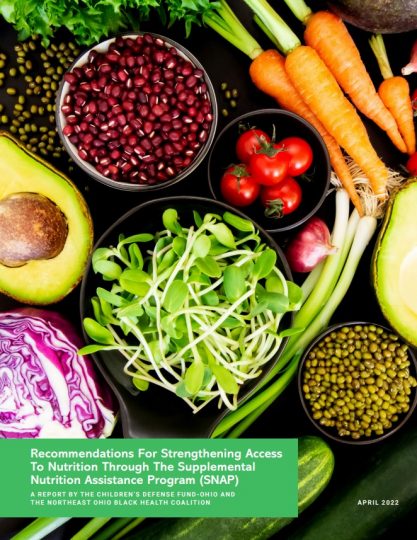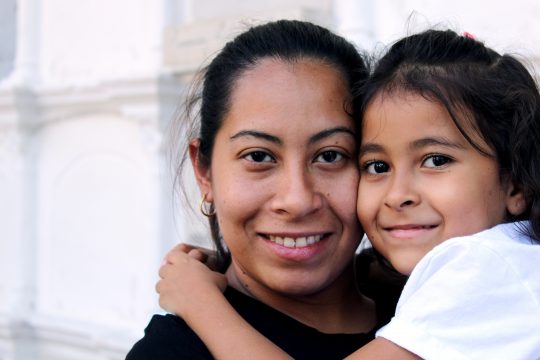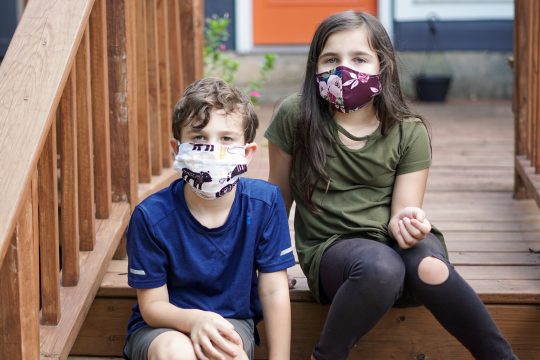 Child Nutrition
Child Nutrition
Over half a million children in Ohio live in poverty. Families who live in poverty are often forced to make impossible choices between basic needs. Prior to the current pandemic, nearly one in five children experienced persistent hunger and that number is only growing as more families are losing income, unemployment benefits, and the safety nets in our society are becoming thread bare. Oftentimes, our schools fill critical roles in our communities to help children get the daily nutrition they need. With over a third of children enrolled in these school-based nutrition programs, many children are at risk of going hungry every day leaving many children to lack consistent access to adequate food. The majority live in families with one or more working adults—but are still unable to consistently afford enough food to keep the wolves of hunger from their door.
There is no excuse for any child in America to go hungry and malnourished in the richest nation on Earth. Yet child hunger is a widespread, urgent and shameful problem that cannot wait. We all have to do something—now.
In 2016, Children’s Defense Fund-Ohio published an issue brief on early childhood hunger detailing the health and life risks thousands of Ohio’s youngest children suffer every day. Babies, toddlers, and preschoolers suffering hunger and malnutrition face increased odds of negative health outcomes during their years of greatest brain development. Food insecure children under age five are:
- Nearly two times more likely to be in “fair or poor health”;
- Nearly two times more likely to experience developmental delays;
- Two times as likely to have behavioral problems;
- More than twice as likely to be hospitalized;
- Two and a half times more likely to have headaches, and
- Three times more likely to have stomach aches.
Food insecure children are more likely to be behind in social skills and reading performance in kindergarten. By elementary school they are four times more likely to need mental health counseling. Risks keep accumulating: malnutrition from childhood food insecurity has been linked to adult diseases including diabetes, hyperlipidemia and cardiovascular disease. The stress and anxiety of early childhood hunger also make it harder to learn skills that help later relationship development, school success and workplace productivity.
Babies born to food insecure mothers face tragic odds: they are more likely to be born pre-term and at low birthweight and to struggle with breastfeeding which contributes to increased infant mortality rates. Babies who survive are more likely to struggle with disabilities during childhood and adolescence and face higher risks of chronic disease as adults. School-age food supports of free and reduced price breakfast and lunch are critically important to the health and academic success of older children but young children should not be forced to suffer from lack of food.
Child Hunger Increasing During Pandemic
The Families First Coronavirus Response Act and the Coronavirus Aid, Relief and Economic Security Act provided support for families and children however much more must be done to address rising child hunger and poverty in the state and more Ohioans find themselves unemployed and lacking basic resources.
Ohioans are increasingly experiencing food insecurity. By the end of April, more than one in five households said their children were not getting enough to eat and two in five households made up of mothers with children under 12 were experiencing food insecurity. This is not an acceptable reality. Congress must take the following actions to ensure that our children and families do not suffer from hunger during this public health emergency.
Increase the SNAP maximum benefit amount and provide greater access to food for families using SNAP to meet their basic nutrition needs
SNAP benefits must be increased. A nationwide 15% increase in SNAP allotments and raise minimum benefits from $16 to $30 to improve access to nutritious foods for every SNAP household. Food stamp applications have surged as over 1.5 million Ohioans have lost their jobs. Prior to the pandemic 1.3 million Ohioans received SNAP benefits each month, and in the week ending April 11, about 29,334 new Ohioans applied for food stamp benefits—a 172% increase from April 2019.
We were recently introduced to Jami Clinkscale of Columbus. Jami relies on a $580 per month disability check to make ends meet. After COVID-19 hit, she went from feeding two people to six after taking in her grandchildren when their mother got evicted. Jami is struggling to feed her family on just $170 a month in SNAP benefits. She is often forced to supplement SNAP benefits with food pantries and skip meals so her grandchildren do not go hungry. As Jami said, “I’ve eaten a lot less just to make sure they get what they need.”
Jami’s experience today demonstrates that SNAP benefits are too low to adequately feed many families. SNAP benefits average only $1.40 per person a meal and almost half of families use their monthly allotments within the first few weeks of the month. With unemployment and hardship on the rise, families’ food budgets are only being stretched even further. We must urgently expand SNAP benefits to provide these families much-needed relief. Increasing SNAP benefits will not only help Ohioans keep food on the table, but will also stimulate Ohio’s economy as these dollars are spent at local retailers.
During this crisis and beyond, it is also critical that we allow greater access to food for SNAP families. To do this, the next Relief Package should
(1) provide families using SNAP benefits with the option to use their benefits to purchase hot food products ready for immediate consumption;
(2) suspend all SNAP administrative rules that would terminate or weaken benefits; and
(3) suspend the three-month SNAP time limit for unemployed adults without minors for the duration of the economic downturn. The Families First legislation only suspended these rules for the duration of the public health emergency, but an extension is needed to ensure coverage continues while the economy is weak and unemployment is high.
Lastly, the state of Ohio experienced significant job growth and was seeing positive economic signals before the pandemic. In a matter of months we have seen a dramatic spike in our unemployment numbers. It will take time to recover economically and for jobs to return and businesses to re-open. All SNAP administrative rules that would terminate or weaken benefits must be suspended for the remainder of the economic downturn.
Extend the Pandemic-EBT (P-EBT) Program to provide continued relief to children and families
With over 1.6 million children learning from home during the months of March through the begiing of June, many children missed out on school breakfasts and lunches. Oftentimes and for many children, these meals are a critical source of nutrition during the school week. In response, the Ohio’s Pandemic-EBT program was approved in early May. The program, administered by ODJFS, provides up to $302.00 to students who are eligible for free or reduced-priced meals and pumps a total of $254 million directly into our economy. While these funds provide some financial relief for families struggling to put food on the table, they will not dissipate hunger over the summer months. Through the hard work of our state agencies to get the Pandemic-EBT program up and running, we have the infrastructure in place to provide additional funds to these food-insecure children and families.
In addition, P-EBT funds in Ohio only went out to K-12th graders, leaving behind our youngest children. P-EBT benefits should be extended to young children who received free or reduced-price meals in preschool and childcare programs.
As recently as July 30th, we have heard that counties throughout the state of Ohio began announcing that school districts within their boundaries and under their public health department authority will remain closed for a portion or the entire fall semester. With our school buildings remaining closed and students engaging in school through hybrid and distanced learning, they will once again be without nutrition support. We must continue the P-EBT program to make sure children and families have access to nutrition.
 New! CDF-Ohio Partnered with Community Organizations Across Ohio to Learn about Barriers, Challenges, and Opportunities to Improve the SNAP Program for People Who Need it.
New! CDF-Ohio Partnered with Community Organizations Across Ohio to Learn about Barriers, Challenges, and Opportunities to Improve the SNAP Program for People Who Need it.
Through support from the Center for Science in the Public Interest (CSPI), Children’s Defense Fund-Ohio (CDF-Ohio) and the Northeast Ohio Black Health Coalition, in collaboration with five community organizations, facilitated focus groups and interviews with 86 current or former SNAP participants, hosted a statewide SNAP stakeholder convening, and conducted six individual key informant interviews. The goal of these sessions was to identify challenges with and opportunities to strengthen healthy eating through participation in SNAP. This report seeks to elevate SNAP participants’, community members’, and stakeholders’ experiences by recommending initiatives that may improve access to healthy eating through participation in SNAP.
Blog Posts
 Barriers to accessing and navigating OhioWIC: user experiences can inform improvements
Barriers to accessing and navigating OhioWIC: user experiences can inform improvements
May 2, 2022
Katherine Ungar – Policy Associate – Children’s Defense Fund-Ohio (kungar@childrensdefense.org)
Hope A. Lane-Gavin – Fellow, Health Equity – The Center for Community Solutions (hlane@communitysolutions.com)
Over the past several months, The Center for Community Solutions and Children’s Defense Fund-Ohio have worked together to evaluate the Special Supplemental Nutrition Program to Women, Infants, and Children (WIC). WIC is a critical program, with a proven track record for not only improving infant mortality and maternal health, but for contributing to the long-term health, growth, and cognitive development benefits to children. To learn more about the personal experiences and impressions of OhioWIC, we are speaking with both WIC participants and WIC program directors across the state. In these conversations, WIC participants and directors have identified a number of barriers to accessing or utilizing the program. Our hope is to bring awareness to these challenges, remove or mitigate them, and improve user experience through public policy. Download full issue brief here.
 Child Nutrition Reauthorization (CNR) – An Opportunity to End Child Hunger
Child Nutrition Reauthorization (CNR) – An Opportunity to End Child Hunger
March 9, 2021
By Katherine Ungar, JD, Policy Associate
There has never been a greater need to strengthen our federal child nutrition policies and programs than now. The Covid-19 pandemic has resulted in overwhelming and unprecedented levels of child hunger across our nation. Consequences of child hunger go beyond not having enough food. Children’s physical and mental health depend on them receiving enough nutrients each day. Malnutrition undermines a child’s ability to flourish and reach their full learning potential.
Thanks to federal programs, millions of children benefit from the school nutrition programs authorized by the federal government. Federal nutrition programs play a critical role in helping to reduce child hunger and must be strengthened to meet the needs of all children. These programs touch millions of children each day and lead to improved child well-being.
 Nutrition Support Means Greater Higher Education Access & Equity for Ohioans
Nutrition Support Means Greater Higher Education Access & Equity for Ohioans
February 19, 2021
By Alex F. Coccia, Policy Consultant
All Ohioans, their families, and their communities stand to benefit from a thriving higher education system that prioritizes access and affordability of its institutions, including the ability for those attending them to meet their own basic needs as they are pursuing their degrees.
A hallmark of Ohio is our robust and expansive higher education system, comprising 14 public universities, 24 regional branch campuses, 23 community colleges, and over 70 not-for-profit colleges and universities. Accessible higher education is a fundamental force for equity, economic mobility, community investment and development, and enhancing the knowledge and skills of Ohioans to pursue employment of their choosing and gain greater stability for their families. However, a crisis has been looming on the horizon for higher education institutions in Ohio and across the country for well over a decade now, further exposed and intensified by the pandemic.
Between 2008 and 2018, higher education has seen financial challenges across the country. While Ohio has held off major increases in tuition for public, four-year colleges since the recession (5.2% compared to 106.9% in Louisiana), our state has spent 16.9% less per student in that time period. These tuition increases and financial aid decreases have fallen disproportionately on the shoulders of Black and Latinx families in Ohio, for whom the average price of attendance at a public four-year university is 52 and 41% of median income, respectively, compared to 31% overall. These tuition increases can be cost prohibitive for students with low-incomes seeking college degrees, increase the debt students take on, and reduce future earnings, especially when paired with student loan repayment.
Ohio Children are Hungry – Work Requirements and Other Barriers are Not the Answer
February 8, 2021
By Alex F. Coccia, D.Phil., Policy Consultant
The wealthiest nation in the world should not have a hunger crisis – and yet, more than one in four children in Ohio (27.1%) will live in food insecure households (up from 18.9% in 2018). For Black, Latino, and Indigenous children, food insecurity is even more prevalent.
 The structural racism driving persistent inequities in income, education, medical care, employment, and housing also creates policy and program barriers for families of color to meet the nutritional needs of their children. According to the Census Bureau’s most recent survey, Black and Latino adults were more than twice as likely as White adults to report that their household did not get enough to eat (19 percent and 21, respectively, compared to 8).
The structural racism driving persistent inequities in income, education, medical care, employment, and housing also creates policy and program barriers for families of color to meet the nutritional needs of their children. According to the Census Bureau’s most recent survey, Black and Latino adults were more than twice as likely as White adults to report that their household did not get enough to eat (19 percent and 21, respectively, compared to 8).
As I wrote about previously, the Supplemental Nutrition Assistance Program (SNAP) is one of the most effective safety-net programs at reaching eligible people, providing access to nutritious meals that are unaffordable for many families, and alleviating the most extreme poverty and hunger. It is a lifeline for children in Ohio, where 40.3% of households receiving SNAP benefits have children. Political scientist Linda Williams found that the Food Stamp Program (renamed SNAP in 2008) greatly contributed to reducing hunger and malnutrition for Americans in poverty, and had far-reaching impacts for the health of Black Americans, drastically reducing both infant mortality and malnutrition rates within five years of its implementation. The program is also a boon to the economy with the over $2 billion distributed through SNAP to Ohioans generating over $3.4 billion in economic activity.
 SNAP Expanded to Temporarily Benefit Ohio College Students
SNAP Expanded to Temporarily Benefit Ohio College Students
February 3, 2021
By Alex F. Coccia, D.Phil., Policy Consultant
College students have faced severe disruption and instability because of the pandemic. Recent temporary changes to the Supplemental Nutrition Assistance Program (SNAP) can help them access nutritional assistance and provide millions of dollars to local Ohio economies.
SNAP is one of the largest safety-net programs, serving nearly 1.4 million Ohioans in 2019. It is also incredibly effective at responding to changes in the economy, improving health outcomes, reducing poverty and food insecurity for children, boosting the income of families who work low-paying jobs or are searching for work, supporting individuals with caregiving responsibilities or face barriers to work, investing in local economies, and reaching those eligible.
Despite the successes of the program, college students with low-incomes have long been excluded from SNAP, even with high rates experiencing food insecurity.
Ohio Must Prepare to Quickly Extend P-EBT Benefits to Youngest Ohioans 
January 28, 2021
By Alex F. Coccia, D.Phil., Policy Consultant
Although Ohio still is awaiting guidance from the federal government, soon many Ohio children enrolled in child care will be able to access direly needed pandemic nutritional support for the first time since the pandemic began.
Children in Ohio are at a heightened risk of experiencing poverty, especially during the pandemic, and it has become increasingly difficult for their parents and caregivers to put food on the table. Data from the American Community Survey taken from 2015-2019 show that 20% of Ohio children live in poverty, i.e. in households with income of less than $26,000 for a family of four. In 2019, 170,000 of these children experiencing poverty were under the age of six. We also know that Black and Hispanic children have higher rates, 46% and 38% respectively, compared to 14% of white children.
 Congress Passes COVID Relief: A Summary of the Legislation & Where it Falls Short
Congress Passes COVID Relief: A Summary of the Legislation & Where it Falls Short
December 22, 2020
By Kelly Vyzral, Senior Health Policy Asssociate
After months of stalemates and negotiations, Congress has finally passed much needed COVID relief legislation. The following is a summary of the Consolidated Appropriations Act of 2021. Analyses of specific provisions will be provided in the weeks ahead as we learn more. Read more here.
 Latest COVID Relief Bill Increases SNAP Benefits Temporarily and Extends P-EBT Program to Young Children
Latest COVID Relief Bill Increases SNAP Benefits Temporarily and Extends P-EBT Program to Young Children
December 22, 2020
By Katherine Ungar, JD, Policy Associate
As I wrote about here and here, the pandemic has numerous consequences—perhaps the most dire of them– hunger. Many families are faced with making the impossible decision of paying rent or buying enough food to feed the family. Around 13% of Americans (27.4 million people) reported they “sometimes or often do not have enough to eat” on a weekly basis, according to the latest Household Pulse Survey released by the U.S. Census Bureau on Dec. 16. This includes 14 million households with children reporting that they do not have enough to eat. That is why we have repeatedly called on Congress to include a SNAP boost in their next relief package. Finally, Congress has acted.
After several months awaiting relief, Congress has agreed upon a $900 billion stimulus package. According to several news reports and a summary of the legislation, the package is expected to include $13 billion in increased benefits for the Supplemental Nutrition Assistance Program (SNAP) and other child nutrition benefits.
 Columbus City Council Hears Testimony on Healthy Options for Children
Columbus City Council Hears Testimony on Healthy Options for Children
Columbus City Council Member, Prescilla Tyson, Chair of the Health Committee, invited The Children’s Defense Fund-Ohio along with the American Heart Association, American Diabetes Association, and Nationwide Children’s Hospital, to offer testimony focused on the importance of “whole child” wellbeing and the providing healthy options for flourishing lives. Council is considering legislation that would make water the default beverage for children’s meals throughout the city of Columbus. Our colleague, Katherine Ungar, met with city council on Thursday, December 3, 2020 and below is an excerpt of her testimony.
 Health Education Standards: Setting an Educational Framework for Ohio’s Children to Lead Healthy Lives
Health Education Standards: Setting an Educational Framework for Ohio’s Children to Lead Healthy Lives
By Katherine Ungar, JD, Policy Associate
Today, on December 8, 2020, Senate Bill 121 (SB 121) will have its 6th hearing in the Senate Education Committee. In short, the bill authorizes the State Board of Education to adopt statewide health education standards for grades kindergarten through twelve. Local Boards of Education then have the choice to utilize the health education standards or not. In other words, no local board of education would be required to adopt those standards. The bill has bi-partisan support, sponsored by Senator Vernon Sykes and Senator Stephanie Kunze with several cosponsors, including, among others, Senator Peggy Lehner, Chair of the Senate Education Committee.
Ohio is the only state in the Country without health education standards.
 Without another Relief Bill from Congress, a Growing Number of Families Cannot Afford to Put Food on the Table
Without another Relief Bill from Congress, a Growing Number of Families Cannot Afford to Put Food on the Table
October 28, 2020
By Katherine Ungar, JD, Policy Associate
The pandemic casts a looming shadow on the state of childhood hunger in our country and right here in Ohio. Feeding America, a national hunger relief organization, predicts that 1 in 4 children could be food insecure by the end of 2020, up from 1 in 7 children in 2019. In a recent household pulse survey by the US Census Bureau, 11.1 percent of adults in Ohio reported that their households “sometimes or often did not have enough food to eat” in the past seven days.
Record-setting unemployment, loss in health care coverage, unexpected expenses, and lack of access to school meals, are among the myriad of reasons why the pandemic has caused a rise in the number of hungry children and families.
Food insecurity not only can impede a child’s ability to develop and learn, but also can cause serious health issues. Children who don’t get enough to eat are more likely to be hospitalized and face higher risks of health conditions like anemia and asthma, putting them at a serious disadvantage at the start of life. Children who struggle to get enough to eat are more likely to repeat a grade in elementary school, experience development impairments in areas like language and motor skills, and face more problems in school and other social settings. Congress MUST act quickly to pass a second relief package in order to keep our children fed and prevent them from going hungry.
 Food Deserts in Appalachia: The Impacts of COVID-19 on Families and Children
Food Deserts in Appalachia: The Impacts of COVID-19 on Families and Children
October 6, 2020
By Elinor Broy, College Intern
Not only are rates of unemployment, homelessness, poverty, and food insecurity continuing to rise in Ohio and across the country due to COVID-19, but also, more families and children are living in food deserts with limited access to healthy and affordable nutrients. With local businesses and stores closing and corporate grocery chains full of empty shelves, many lower income, rural communities do not have sufficient access to basic needs, including food.
The detrimental effects of COVID-19 have resulted in more families qualifying for SNAP benefits and longer food pantry lines, but with less fresh and healthy food resources to accommodate these increasing needs. According to the Brookings Institution, currently there are 14 million children in the United States in need of immediate food assistance. Read more here.
 Critical Food Initiatives for Ohio’s Children
Critical Food Initiatives for Ohio’s Children
August 13, 2020
By Katherine Ungar, JD, Policy Associate
Food insecurity across the United States has drastically increased both here in Ohio and across the country. From March to June, the number of Ohioans who reported that they “sometimes or often did not have enough to eat” rose by 30%, a number that will likely continue to increase as families lose unemployment benefits and are offered no additional relief. No Kid Hungry reports that prior to the Pandemic, 1 in 7 kids in the United States lived with hunger, but as schools and businesses close and budgets are stretched thin, that number could rise to 1 in 4 children. 1 in 7 children is too many, 1 in 4 is appalling. We have the tools to fight hunger, we need action.
The Pandemic-EBT Program, authorized by the Coronavirus Relief Act, has been shown to reduce food insecurity.
The Families First Coronavirus Response Act and the Coronavirus Aid, Relief and Economic Security Act provided support for families and children, including approving a Pandemic-EBT program. Almost every state submitted a plan and has been approved to operate a P-EBT program in their state. A newly released report from the Brookings Institute analyzed the P-EBT program across the country, and concluded that the program made a significant impact on child food security. Read more here.
 Ohioans are Increasingly Experiencing Food Insecurity, an Unacceptable Reality in 2020
Ohioans are Increasingly Experiencing Food Insecurity, an Unacceptable Reality in 2020
The state of food insecurity in our country
May 8, 2020
By Katherine Ungar, JD Policy Associate
As a result of the public health emergency, food insecurity across the United States has drastically increased. By the end of April, more than one in five households say their children are not getting enough to eat, a rate three times higher than during the 2008 Great Recession. The U.S. Department of Agriculture (USDA) defines food insecurity as a lack of consistent access to enough food for an active, healthy life. Food insecurity is one metric used to measure and assess the risk of hunger.
Food insecurity is a complex problem and often does not exist in isolation. Working families may face food insecurity for a countless number of reasons, including lay-offs at work, medical expenses, or an unexpected car accident or maintenance. The pandemic has exposed many families to this surprising and harsh reality.
Meeting Children’s Nutritional Needs in Uncertain Times
April 2, 2020
By Katherine Ungar, JD, Policy Associate and with contributions from Tziporah Tiller, College Intern
School breakfast and lunch programs provide our children much-needed nutritious meals so they can learn and be healthy. Children who come from food-insecure homes obtain a significant portion of their daily calories and nutrients from the meals they receive at schools. Programs like the National School Lunch Program (NSLP) ensure children receive meals at school. The NSLP has been shown to reduce childhood food insecurity, poor health, and obesity. National and state programs like NSLP are critical for the well-being of our children, particularly food insecure and low-income children. Read more here.
Resources
Ohio P-EBT Program: Visit this website for more information about the problem and to find out more about eligibility and benefits
Press Release: Boost food aid to fight hunger, bolster economy, July 29, 2020
SNAP Must Be Strengthened to Fight Child Hunger During the Pandemic and Beyond, May 2020
The Early Childhood Hunger Imperative, January 2016

 Child Nutrition
Child Nutrition Barriers to accessing and navigating OhioWIC: user experiences can inform improvements
Barriers to accessing and navigating OhioWIC: user experiences can inform improvements Critical Food Initiatives for Ohio’s Children
Critical Food Initiatives for Ohio’s Children